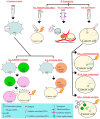Recent Advances and Mechanisms of Phage-Based Therapies in Cancer Treatment
- PMID: 39337427
- PMCID: PMC11432602
- DOI: 10.3390/ijms25189938
Recent Advances and Mechanisms of Phage-Based Therapies in Cancer Treatment
Abstract
The increasing interest in bacteriophage technology has prompted its novel applications to treat different medical conditions, most interestingly cancer. Due to their high specificity, manipulability, nontoxicity, and nanosize nature, phages are promising carriers in targeted therapy and cancer immunotherapy. This approach is particularly timely, as current challenges in cancer research include damage to healthy cells, inefficiency in targeting, obstruction by biological barriers, and drug resistance. Some cancers are being kept at the forefront of phage research, such as colorectal cancer and HCC, while others like lymphoma, cervical cancer, and myeloma have not been retouched in a decade. Common mechanisms are immunogenic antigen display on phage coats and the use of phage as transporters to carry drugs, genes, and other molecules. To date, popular phage treatments being tested are gene therapy and phage-based vaccines using M13 and λ phage, with some vaccines having advanced to human clinical trials. The results from most of these studies have been promising, but limitations in phage-based therapies such as reticuloendothelial system clearance or diffusion inefficiency must be addressed. Before phage-based therapies for cancer can be successfully used in oncology practice, more in-depth research and support from local governments are required.
Keywords: cancer therapy; gene therapy; immunity; peptide display; phage.
Conflict of interest statement
Author T.-Y.Y. was employed by the company Auxergen Inc. The remaining author declares that the research was conducted in the absence of any commercial or financial relationships that could be construed as a potential conflict of interest.
Figures

Similar articles
-
The viral approach to breast cancer immunotherapy.J Cell Physiol. 2019 Feb;234(2):1257-1267. doi: 10.1002/jcp.27150. Epub 2018 Aug 26. J Cell Physiol. 2019. PMID: 30146692 Review.
-
Formulation, stabilisation and encapsulation of bacteriophage for phage therapy.Adv Colloid Interface Sci. 2017 Nov;249:100-133. doi: 10.1016/j.cis.2017.05.014. Epub 2017 May 14. Adv Colloid Interface Sci. 2017. PMID: 28688779 Review.
-
Bacteriophages as Solid Tumor Theragnostic Agents.Int J Mol Sci. 2021 Dec 30;23(1):402. doi: 10.3390/ijms23010402. Int J Mol Sci. 2021. PMID: 35008840 Free PMC article. Review.
-
Engineered Phage-Based Cancer Vaccines: Current Advances and Future Directions.Vaccines (Basel). 2023 Apr 29;11(5):919. doi: 10.3390/vaccines11050919. Vaccines (Basel). 2023. PMID: 37243023 Free PMC article. Review.
-
Back to the future: bacteriophages as promising therapeutic tools.HLA. 2016 Mar;87(3):133-40. doi: 10.1111/tan.12742. Epub 2016 Feb 19. HLA. 2016. PMID: 26891965 Review.
Cited by
-
Targeting breast cancer: the promise of phage-based nanomedicines.Breast Cancer Res Treat. 2025 Jun;211(3):561-580. doi: 10.1007/s10549-025-07696-5. Epub 2025 Apr 17. Breast Cancer Res Treat. 2025. PMID: 40244536 Review.
-
The tumor microbiome in cancer progression: mechanisms and therapeutic potential.Mol Cancer. 2025 Jul 15;24(1):195. doi: 10.1186/s12943-025-02403-w. Mol Cancer. 2025. PMID: 40665305 Free PMC article. Review.
-
Phage Therapy in Managing Multidrug-Resistant (MDR) Infections in Cancer Therapy: Innovations, Complications, and Future Directions.Pharmaceutics. 2025 Jun 24;17(7):820. doi: 10.3390/pharmaceutics17070820. Pharmaceutics. 2025. PMID: 40733029 Free PMC article. Review.
-
Exploring the gut microbiome's influence on cancer-associated anemia: Mechanisms, clinical challenges, and innovative therapies.World J Gastrointest Pharmacol Ther. 2025 Jun 5;16(2):105375. doi: 10.4292/wjgpt.v16.i2.105375. World J Gastrointest Pharmacol Ther. 2025. PMID: 40575364 Free PMC article.
-
Insight into Bacteriophage Therapy for Bacterial Infections and Cancer.Mol Biotechnol. 2025 Jul 9. doi: 10.1007/s12033-025-01466-w. Online ahead of print. Mol Biotechnol. 2025. PMID: 40632445 Review.
References
-
- World Health Organization Global Cancer Burden Growing, Amidst Mounting Need for Services. [(accessed on 7 July 2024)]. Available online: https://www.who.int/news/item/01-02-2024-global-cancer-burden-growing--a.... - PMC - PubMed
-
- Centers for Disease Control and Prevention Smoking and Cancer. [(accessed on 7 July 2024)]; Available online: https://www.cdc.gov/tobacco/campaign/tips/diseases/cancer.html#:~:text=C....
-
- International Committee on Taxonomy of Viruses Virus Taxonomy. [(accessed on 7 July 2024)]. Available online: https://ictv.global/report/genome.
Publication types
MeSH terms
Substances
LinkOut - more resources
Full Text Sources
Medical

